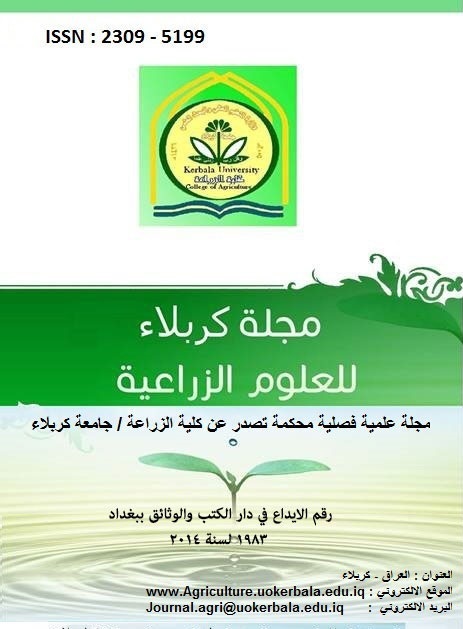Effect of Aspergillus spp., magnetized water and Granstar in control of wild radish weed (Raphanus raphanistrum L.) and growth of wheat plant( Triticum aestivum L.) in one of the fields Al-Hirah in Najaf province
DOI:
https://doi.org/10.59658/jkas.v4i4.312Keywords:
White. Triticum aestivum L, wild radish, Raphanus raphanistrum L. magnetized water.Abstract
magnetized water(MW), the fungus Aspergillus spp. the herbicide Granestar on wheat growth. In a preliminary experiment, magnetized water at three magnetic density levels (1600, 3200, 4800) Gauss was tested to determine the better intensity for seed germination and plant growth of wheat and the wild radish weed. The aim of the study was to control the wild radish in the wheat fields by developing an integrated program to reduce the use of chemical pesticides by using environmentally friendly agents including the bio-agent fungus Aspergillus spp., magnetized water as a physical agent and the Granstar herbicide.
- solani and Aspergillus spp. were isolated from wheat and wild radish seedlings and pathogenically tested on both host plants. Results showed that both R. solani and Aspergillus sp. increased germination and seedlings growth of the wheat and inhibited germination and growth of the wild radish. Aspergillus spp. had no negative effects on seed germination and seedlings growth where tested on different plant families seeds including cow pea, cucumber, radish, barley, melon, garden cress and green mung beans.
Seed germination percentage and seedlings length of wheat and wild radish were affected by magnetic intensity levels after 21 days of planting. The 1600 G was the best treatment for seed germination and seedlings length of wheat, and at the same time this intensity level negatively affected the wild radish seeds and seedlings resulted in the lowest values of germination and seedlings length. However, the highest intensity level 4800 G did support highest seed germination percentage and seedlings length of the wild radish, but this intensity had negative effects on wheat seeds germination and seedlings length.
The main field experiment was conducted during the winter growing season of 2016 in one of Al-Hirah wheat field in the province of Najaf. The experiment was factorial with two factors, MW as main factor and the fungus Aspergillus spp. and the herbicide Granstar at half and full of recommended dose based on RCBD design with three replicates.
The treatment of MW (1600 G) significantly increased all plant growth parameters tested (Weight of spike, weight of 1000 seeds, and total yield) compared to the control (RW). All treatments combinations that included the bio-agent Aspergillus spp. Resulted in enhancing all growth and yield parameters tested with total yield of 5.505 ton.h-1 compared to 2.778 ton.h-1 from the plants not treated with the fungus.
Downloads
Published
How to Cite
Issue
Section
License
Copyright (c) 2017 Copyright (c) 2024 is the Author's article. Published by the Journal of Kerbala for Agricultural Sciences under a CC BY 4.0 license

This work is licensed under a Creative Commons Attribution 4.0 International License.
Licensing Terms
All articles are published under a Creative Commons License and will be directed to the Creative Commons Attribution 4.0 International License (CC BY 4.0) That permits use, distribution, and reproduction in any medium, provided the original work is properly cited. This license also allows the work to be used for commercial purposes.
Use by both non-commercial and commercial users
This content is licensed under a Creative Commons Attribution 4.0 International (CC BY 4.0) license, permitting use by both non-commercial and commercial users. Individual users may access, download, copy, display, and redistribute the articles to colleagues, as well as adapt, translate, and text- and data-mine the content, subject to the following conditions:
- The author's moral rights, including the right of attribution and the right to protect their work from derogatory treatment, are respected.
- Where content in the article is identified as belonging to a third party, users must ensure that any reuse complies with the copyright policies of the owner of that content.
- If the article content is reused for research or educational purposes, users should maintain a link to the appropriate bibliographic citation, including the DOI and a link to the published version on the journal's website.

